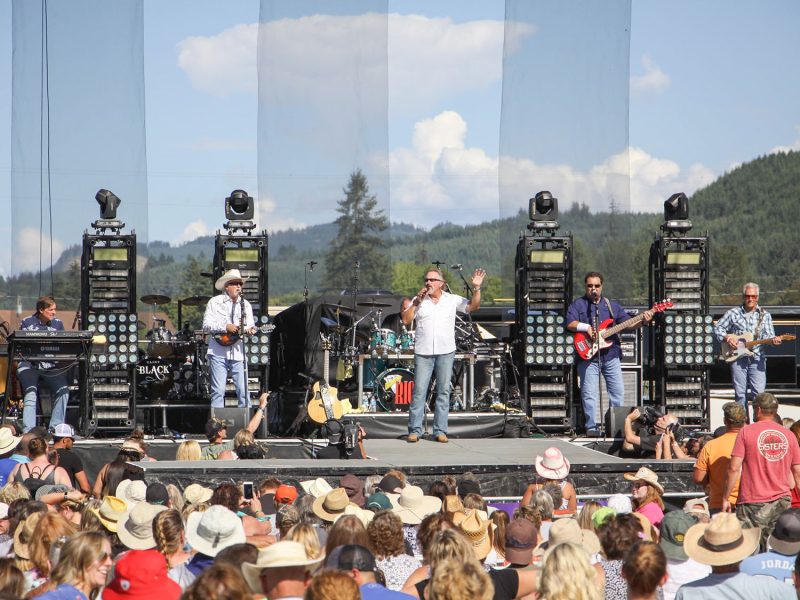The Sweet Home Economic Development Group announced last week that 2025 will be the final year for its Oregon Jamboree Music Festival.
The SHEDG Board of Directors released a statement July 8, three weeks before the 2025 event, announcing their decision to end the annual festival after 34 years.
This year’s festival in Sweet Home is scheduled for Aug. 1-3, featuring headliners Clay Walker, Shane Smith and the Saints, and Jordan Davis.
“While this is not an announcement the board wanted to have to make, as one of the last remaining nonprofit country music festivals in the country, we are deeply proud of the positive contributions we have made to our community and the memories we have helped create for festival attendees over the years,” said Heather Search, president of the SHEDG Board of Directors.
Current SHEDG board members are: Search; Vice President Rob Poirier, Tracey Weidner, Sherri Gregory and Dawn Waldrop.
Multiple Challenges
Poirier, who has been involved with the Jamboree since 1997 in a variety of capacities, said that production and talent costs for festivals such as Sweet Home’s have risen, while ticket sales have declined “as consumer concert event interest has shifted to large single-artist stadium-style events over multi-day music festivals.”
“At the end of the day, the board determined that the numbers simply didn’t pencil out and the costs of running the event outpaced revenue from ticket sales and sponsorships,” he said in an email. “Frankly, the Oregon Jamboree has been able to go on for the length it has because of our dedicated fans, sponsors, volunteers and staff.”
Home-Grown Production
The Oregon Jamboree has always been distinctly home-grown.
It was born out of a community effort generated by a series of economic blows in the late 1980s to Sweet Home’s timber industry – fire danger, a strike, and then the shutdown of millions of acres of federal timberland due to the listing of the northern spotted owl under the federal Endangered Species Act. Significant layoffs and mill closures resulted.
Alex and Debbie Paul, former publishers of The New Era, recounted the economic turmoil in a 2017 newspaper article.
Sweet Home, then a community of 6,000, lost 1,000 jobs, Alex Paul said. Some 30 years ago, every piece of wood necessary to build a house was produced in Sweet Home. Today, it’s down to veneer and specialty products.
At one point, there were 30 empty storefronts on Main Street, Debbie Paul said.
The community rallied in various ways and then-mayor Dave Holley worked with the state economic development agency to complete an economic analysis for Sweet Home. The grassroots SHEDG was founded in 1991 to help the city transition from its timber-based economy.
SHEDG founded the Oregon Jamboree, country music and camping festival in 1992 as a fundraising tool to pay for economic development projects.
The festival was the brainchild of local residents Marge Geil and Leslie Ancke, along with Scott Proctor of the Oregon Department of Forestry, who came up with the idea of a fund-raising concert after Geil and Ancke attended a Wynonna Judd performance back east, and pitched the idea to her of performing in Sweet Home.
Wynonna committed to performing at the concert for two years. She later returned, in 2012 for the Jamboree’s 20th anniversary.
It kept going, although in 1995 SHEDG board members and event organizers had to pony up $62,000 from their own pockets and land a $50,000 loan from Linn County after that year’s production lost $112,000.
Things improved after that. The 1996 event, featuring Tim McGraw and Faith Hill, finished solidly in the black. By the early 2000s, the Jamboree reported profits of six figures, which continued until another threat arose.
The birth of the Willamette Country Music Festival in 2008 in Brownsville posed serious challenges to the Jamboree’s survival.
The competing festival was held two weeks after the Jamboree on a site literally 15 miles down the road for some 10 years, with heavy sponsorship and marketing by Bi-Mart, featuring top-name artists that the nonprofit Jamboree could not afford.
It lasted until 2018, when allegations of unpaid bills began to surface and crowd behavior issues prompted the Linn County Sheriff’s Office to decline to provide security.
Although the WCMF’s presence was a challenge, Poirier said he believes it made the Oregon Jamboree “better.”
“There were challenges, to be sure,” he said. “Competing for talent was a big thing, due to the proximity.
“The simple truth, however, is that the WDMF closed its doors and we were able to continue for many more years.”
The WCMF years were closely followed by the COVID pandemic, which forced the cancellation of Oregon Jamboree plans for 2020 and resulted in a late start on planning for the 2021 festival, which was not announced until April of that year.
More recently, Poirier said, fans and artists in recent years are moving to “the larger stadium show experience,” which has “impacted festivals in general.”
A National Public Radio Planet Money newsletter article published last year reported that “a wave of festivals has been unplugging their microphones and telling pass holders, ‘Sorry!’”
The article cited rising costs and “softening demand,” which makes it hard to raise prices to cover those rising costs.
“This trend has not been limited to the country music genre,” Poirier said. “It has impacted festivals in general.
“We are not the only ones facing these challenges, but it was important to our board that we made this decision in a financially responsible way when we could still fulfill our commitments to talent, vendors, and our community, and hold one final celebration of this important community event.”
Poirier acknowledged that producing the Oregon Jamboree has become more complex over the decades.
“In the earlier years, things were simpler, but we’ve always had a reputation for having a clean and family-friendly venue,” he said.
“This largely volunteer-run event has certainly evolved into something this community should be proud of. We impacted the local economy for sure. More importantly, we found a place for every community member to pitch in and be proud to be a part of something great, according to his or her ability.”
A Visitor Profile and Economic Impact Assessment produced by the Jamboree in 2022 reported that approximately 14,500 people attended the festival that year, spending an estimated $3 million at the event and an additional $1.5 million in the community outside the event.
“This visitor spending, combined with the resulting supply chain purchases and spending of wages, created a total economic impact of $6.6 million in additional business revenue, along with 59 jobs and $2.2 million in salaries and wages,” the assessment stated.
Asked about the future of SHEDG as an organization, Poirier said that will be determined once this year’s festival is over.
“As with any announcement of this scale, there are still some logistical details being worked out,” he said. “Currently, the board is focused on supporting our staff and volunteers in making the 34th annual Oregon Jamboree the best event ever. We have a lot of people to thank and a whole lot of reasons to celebrate.
“Once this event has concluded, those are the very questions the board will turn its attention to. We will certainly provide updates to the community as we know more about the future of SHEDG.”
For more information about what this means for 2026, including information on 2026 ticket refunds, visit www.OregonJamboree.com/closureFAQs.





